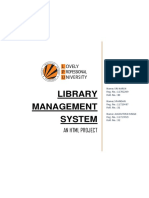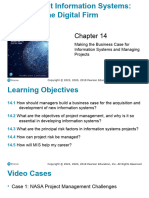Library Management System Documentation
1. INTRODUCTION
In today's digital era, libraries still face challenges in managing thousands of books, tracking borrow/return
records, and avoiding manual errors. Traditional systems are paper-based, leading to data loss,
time-consuming search processes, and human mistakes. To overcome these challenges, our Library
Management System (LMS) project aims to streamline library operations by automating core activities such as
book cataloging, issue/return management, fine calculation, and member records.
The LMS is developed using Java (for the front-end) and MySQL (for the database). We have designed the
system to be user-friendly, secure, and capable of handling a large number of book and member records. The
system includes role-based access for librarians and administrators, ensuring data integrity and reducing
manual intervention.
This project was developed after understanding the real-life problems faced by library staff in educational
institutions, where managing resources manually often results in loss of books, data inconsistency, and
ineffective tracking of borrowers.
�2. OBJECTIVE
The primary objective of our Library Management System Project is to automate and digitize the entire library
process. The specific goals are:
- Maintain accurate records of books, members, and transactions.
- Automate the book issue and return process to reduce time and manual effort.
- Provide a search feature to quickly locate books by title, author, or ISBN.
- Track book availability in real-time to avoid issuing already borrowed books.
- Automate fine calculation for overdue returns.
- Generate reports on book inventory, member activity, and fines collected.
- Minimize human error by using a digital system instead of manual registers.
- Simplify new book additions and old book deletions with minimal steps.
- Ensure data security by providing access to authorized users only.
- Offer scalability, so more books and users can be added as the library grows.
�3. SYSTEM ANALYSIS
System analysis helps in understanding the current problems faced by libraries and defines the requirements
for an automated solution. It involves identifying the needs, conducting preliminary investigation, and
ensuring feasibility of the new system to replace the manual one effectively.
�3.1 IDENTIFICATION OF NEED
Through direct interaction with library staff and users, we identified the following needs:
- Manual record maintenance leads to data loss and redundancy.
- Inefficient search process for book availability.
- Inaccurate fine calculation for overdue books.
- Lack of access control resulting in data manipulation.
- No automated reporting system for audits and inventory checks.
These challenges make a strong case for developing a Library Management System that automates the above
processes.
�3.2 PRELIMINARY INVESTIGATION
We studied the existing manual system and identified major gaps such as time-consuming updates, missing
entries, and complaints from users about book tracking. Stakeholder interviews highlighted the need for easier
management, quick book tracking, and secure record keeping. Existing commercial solutions were either too
expensive or not customizable, so building an in-house solution was chosen.
�3.3 FEASIBILITY STUDY
Technical Feasibility:
- Java and MySQL are used due to their wide availability and cost-effectiveness.
Economic Feasibility:
- Development is done in-house with minimal costs using existing hardware.
Operational Feasibility:
- The system will reduce workload and improve efficiency, making it well-accepted by the library staff.
Schedule Feasibility:
- The project timeline is realistic and achievable with the available resources.





























































































